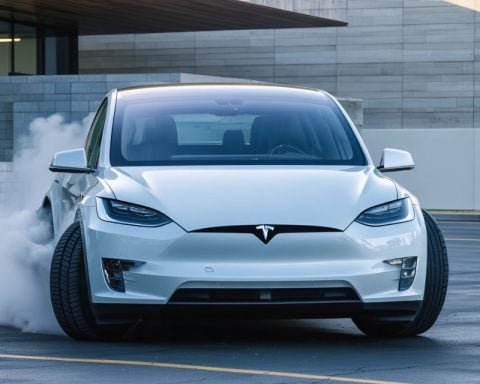- Tesla’s ambition extends beyond electric vehicles, with plans in autonomous vehicles, AI, and robotics, epitomized by the Optimus Robot.
- Despite past sales growth, Tesla’s electric vehicle sales slightly declined to 1.79 million in 2024, trailing behind rivals like China’s BYD.
- Tesla’s ‘Cybercab’, due by 2026, aims to transform ride-hailing with autonomous technology, underpinned by significant AI investment.
- The Optimus Robot symbolizes Tesla’s broader ambitions, although technical challenges remain for its potential valuation impact.
- Investors are cautioned to balance Tesla’s expansive vision against past unfulfilled promises and the current financial outlook.
- Tesla’s market valuation of $1.1 trillion contrasts sharply with its cash flow, exemplifying the tension between high expectations and fiscal reality.
Amidst the neon glow of ambition and innovation, Tesla’s bold new ventures stand as shimmering beacons in the technological horizon. Although fiercely entrenched in the electric vehicle realm, Tesla’s aspirations stretch far beyond—daring to redefine transportation with autonomous vehicles, pioneering AI advancements, and venturing into robotics with the visionary Optimus Robot.
The Ailing Electric Heart
Yet, the road ahead isn’t without its potholes. Tesla’s core strength—electric vehicle sales—unfortunately mirrors a display window with scattered patrons. After a meteoric rise from 500,000 units in 2020 to 1.8 million in 2023, 2024 saw a slight decline to 1.79 million. Despite slashed prices aiming to electrify demand, competitors like China’s BYD surge ahead, leaving Tesla trailing in key markets.
The Allure of the Future
Still, hope courses through Tesla’s veins, powered by audacious projects. Envision the ‘Cybercab’, claiming a posture of autonomy poised to redefine ride-hailing by 2026. Fueling this drive is Tesla’s zealous in-house AI investment, promising revolution in self-driving tech and, potentially, taxi networks.
And in a leap from automotive, we glimpse the nascent Optimus Robot—a harbinger of Musk’s vision for a $25 trillion valuation dream. Yet, this frontier remains clouded with technical puzzles still unsolved.
A Skeptic’s Reflection
While these audacious plans shimmer with possibility, they also sway under the weight of past unrealized promises. Historical musings by Musk, projecting fully self-driving cars within mere years, remain an unmanifested enigma nearly a decade later.
For investors entranced by Tesla’s narrative, reality demands a grounding. The market roars with a valuation of $1.1 trillion, juxtaposed against a more modest $3.6 billion cash flow—a dizzying 300-fold promise of future profits. Step cautiously, for expectation and reality may not always converge.
Can Tesla’s Vision Overcome the Challenges Ahead? Discover the Latest Industry Insights!
How-To Steps & Life Hacks
1. Maximize EV Efficiency:
– Drive at moderate speeds to conserve battery life.
– Plan routes using Tesla’s integrated navigation for optimized travel.
– Use scheduled charging to take advantage of off-peak electricity rates.
2. Stay Updated on AI Technology:
– Follow Tesla’s software updates to benefit from improvements in autonomous features.
– Utilize Tesla blogs and forums to stay informed on AI advancements and how they affect vehicle performance.
Real-World Use Cases
– Autonomous Ride-Hailing:
Tesla’s ‘Cybercab’ promises a transformation in urban transportation, potentially reducing the need for personal car ownership and influencing city planning and traffic management.
– Home & Work Robotics:
The Optimus Robot could redefine household chores and routine workplace tasks, becoming a staple in both personal and professional environments.
Market Forecasts & Industry Trends
– Electric Vehicle Market:
The global EV market is projected to grow from $287 billion in 2021 to over $1 trillion by 2030, with key contributions from Asia-Pacific markets like China, where companies such as BYD are leading the way (Statista).
– AI in Automotive:
AI integration in the automotive sector is set to explode, with expected valuation reaching approximately $116 billion by 2027, driven by advancements in autonomous driving capabilities (MarketsandMarkets).
Reviews & Comparisons
– Tesla vs. BYD:
While Tesla focuses on luxury and cutting-edge tech, BYD offers competitively priced alternatives with significant success in the domestic Chinese market. Reviews often highlight Tesla’s innovation edge but question its market adaptability compared to BYD without aggressive price cuts.
Controversies & Limitations
– Autonomy Challenges:
Despite Musk’s optimistic projections, fully autonomous driving remains beyond current technology capabilities, with regulatory hurdles and safety liabilities delaying widespread rollout.
– Financial Speculation:
Critiques arise from Tesla’s stratospheric valuation that contrasts starkly with its actual cash flow, raising concerns over potential market volatility.
Features, Specs & Pricing
– EV Features:
Tesla vehicles boast industry-leading range, advanced software updates, and autonomous capabilities. However, features like full self-driving come at a premium, with nuanced pricing structures often dependent on geographical location.
Security & Sustainability
– Data Security:
Tesla vehicles collect vast amounts of data crucial for autonomous driving, yet concerns persist about data privacy and cybersecurity risks.
– Environmental Impact:
Despite being zero-emission at the tailpipe, Tesla faces scrutiny over battery production’s environmental footprint and efforts toward sustainable sourcing of raw materials.
Insights & Predictions
– AI and Robotics:
Tesla’s focus on AI-driven robotics indicates a long-term vision where human-robot collaboration becomes mainstream, possibly altering labor markets significantly by the 2030s.
– EV Evolution:
Expect continuous enhancements in EV range and charging infrastructure, aiding Tesla’s push to mainstream electric vehicles globally.
Pros & Cons Overview
Pros:
– Leading AI and autonomous driving technology.
– Strong brand recognition and customer loyalty.
– Pioneering innovations in robotics and transportation.
Cons:
– Strong market competition, particularly from Chinese companies.
– High dependency on software development and regulatory approvals.
– Valuation risk and financial volatility.
Actionable Recommendations
– Investors: Diversify investments and keep abreast of industry trends, particularly in competitors’ advancements.
– Consumers: Take advantage of Tesla’s software advancements by fully utilizing app functionalities and scheduled updates.
Quick Tips
– Keep your Tesla app updated to enjoy the latest features and improvements.
– Stay informed on regulatory changes affecting autonomous vehicle laws in your region.
– Explore Tesla forums and user communities for tips on maximizing vehicle efficiency and longevity.
For more information, visit Tesla’s official website for direct insights.



















